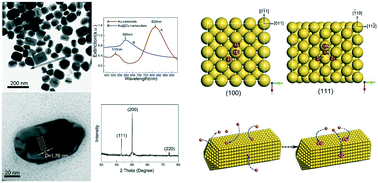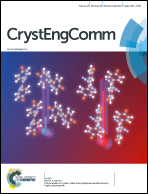Facile synthesis and heteroepitaxial growth mechanism of Au@Cu core–shell bimetallic nanocubes probed by first-principles studies†
Abstract
Bimetallic Au@Cu core–shell nanocrystals have been synthesized by a two-step seed-mediated growth method through controlled heteroepitaxial growth of Cu shells on Au nanorods serving as seeds. The final crystal structures have cubic morphology with edge lengths from 50 to 100 nm due to a strong affinity of hexadecylamine, which is a selective capping agent for the {100} facets of Cu. Various characterizations reveal that the epitaxial growth mechanism is based on block-type growth mode, rather than layer-by-layer growth mode, owing to the larger mismatch in the different lattice constants between Au core and Cu shell. Moreover, contrastive experiments using Au nanobipyramids as seeds were carried out to gain further insight into the heteroepitaxial growth mechanism. Combining first-principles density-functional theory with experimental results, the binding energies of Cu atoms at different sites on Au surfaces are explored to clarify the aspects of nanostructure formation. This study provides useful insights into the effective synthesis method and the further investigation of the proposed growth mechanism.



 Please wait while we load your content...
Please wait while we load your content...